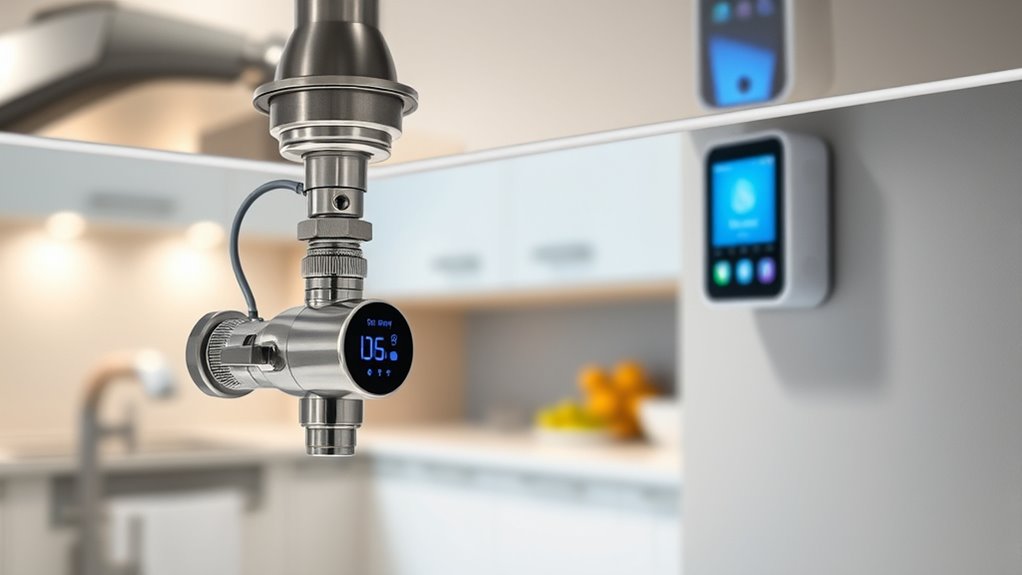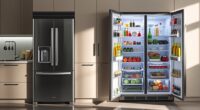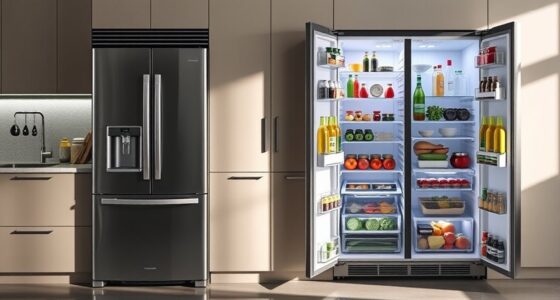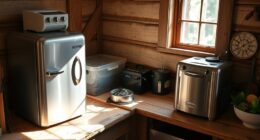Wi-Fi water shutoff valves help prevent floods by detecting leaks early and shutting off the water supply remotely. They provide real-time alerts, allow you to manage your water system from anywhere, and can be integrated with smart home devices. These valves are easy to install, safe, and certified for reliable operation. If you’re interested in safeguarding your home from water damage, discover how advanced features and top devices can make a difference.
Key Takeaways
- Wi-Fi-enabled water shutoff valves detect leaks in real-time and automatically shut off water to prevent flooding.
- Remote access via smartphone apps allows users to monitor and control water flow from anywhere.
- Alerts via text, email, or calls notify homeowners immediately of leaks or abnormal water usage.
- Advanced sensors and AI algorithms enable early leak detection and predictive maintenance, reducing flood risk.
- Certifications and safety features ensure reliable, secure operation, safeguarding homes against water damage.
How Wi‑Fi Connectivity Enhances Water Management
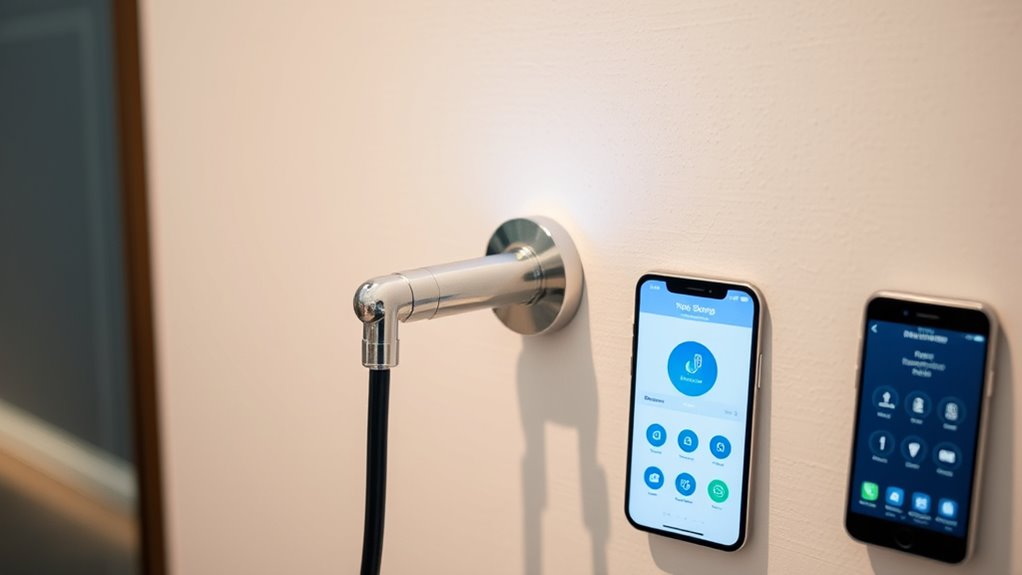
Wi‑Fi connectivity substantially improves water management by enabling real-time leak detection and automated responses. With integrated sensors in water shutoff valves, you receive instant alerts whenever a leak is detected, allowing quick action. The system can automatically shut off water flow, preventing flooding and minimizing damage without your manual intervention. Remote access via Wi-Fi means you can manage your water system from anywhere, whether you’re at home or away. Continuous monitoring helps identify issues early, reducing water waste and localizing repairs. Paired with AI algorithms, these systems can even predict potential failures, supporting proactive maintenance. Wireless communication technologies like Wi-Fi facilitate faster data transmission, ensuring timely responses to water system issues. This seamless connectivity ensures your water system is more efficient, responsive, and capable of preventing costly floods before they happen. Additionally, remote monitoring empowers homeowners to stay informed and react promptly to any anomalies, further enhancing the system’s effectiveness.
Key Features of Modern Water Shutoff Valves
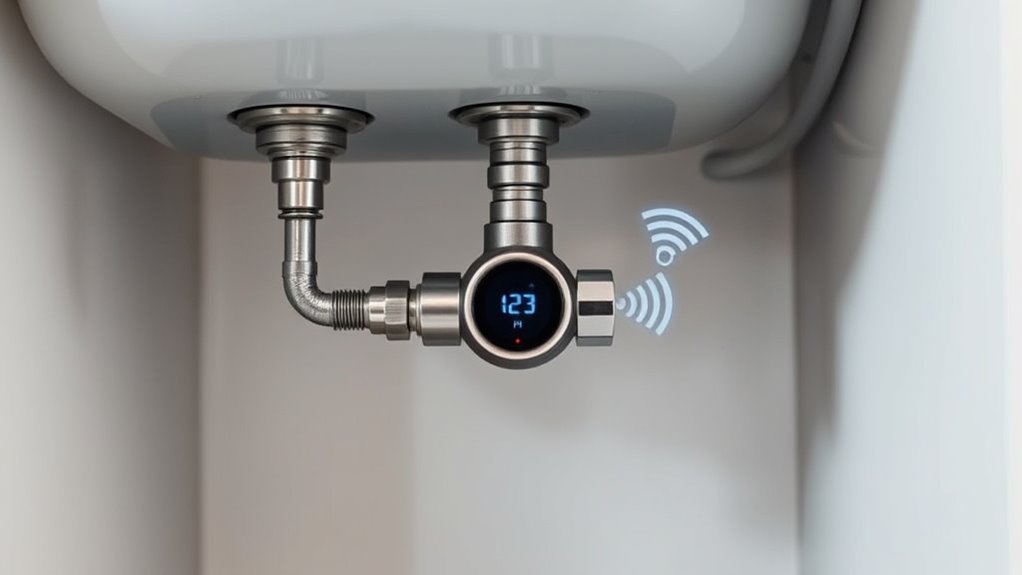
Modern water shutoff valves offer a range of advanced features that enhance your water management. They can automatically shut off water when sensors detect leaks or anomalies, preventing potential flooding. You can also control them remotely through smartphone apps, giving you convenience and peace of mind. Many integrate seamlessly with smart home systems like Amazon Alexa and Google Assistant. Real-time alerts notify you instantly of leaks or unusual water flow, so you’re always informed. These valves are energy-efficient, helping reduce water waste, especially with features like microleak detection and smart learning that identify small leaks and abnormal patterns. Built with durable materials and certified standards, they ensure reliability and safety. Some models also include Wi-Fi connectivity, providing easier setup and integration with existing home networks. Additionally, these systems often feature advanced sensors, which enhance their ability to detect issues early and improve overall home safety. Overall, these modern features provide smarter, safer, and more efficient water control for your home.
Installation Tips for Seamless Integration

Before installing your Wi-Fi water shutoff valve, double-check that your pipes are compatible with the valve’s connections to prevent leaks or damage. Position the valve in an ideal spot—downstream of the main shutoff and after pressure-reducing valves—to ensure smooth operation. Make sure the installation area is clean and dry for easy fitting and proper sealing. Additionally, consider regulatory compliance requirements to ensure your installation meets local safety standards and regulations.
Proper Pipe Compatibility Checks
Ensuring your water shutoff valve fits properly starts with verifying pipe compatibility. First, check that your pipe material matches the device’s supported types, like copper, CPVC, or PEX. Second, measure your pipe diameter accurately to ensure it aligns with the valve’s supported sizes, such as 1″ or 1¼”. Third, confirm the connection type and thread standards, like NPT, to prevent leaks. Fourth, determine if adapters are needed to connect the valve to existing fittings or ball valves, especially if supporting tube sizes from ½ inch to 1.5 inches. By carefully inspecting these aspects, you’ll ensure a secure, leak-free fit and seamless integration for your Wi-Fi shutoff valve. Proper compatibility checks are essential for reliable operation and long-term durability. Additionally, understanding household plumbing components can help you better identify compatible parts and ensure a smooth installation process.
Optimal Installation Placement
Proper placement of your Wi-Fi water shutoff valve is key to reliable operation and easy maintenance. Install it on the main cold water supply line after the water meter, main shut-off, and pressure-reducing valve for full system control. Place it indoors, typically in the basement or garage, where it’s accessible for servicing. Confirm the location supports a strong Wi-Fi signal—test connectivity beforehand and avoid thick walls or metal enclosures. Position the valve downstream of any fire sprinkler system to prevent interference with fire safety. Keep the valve within 10 feet of an electrical outlet or plan for wiring. Confirm the pipe orientation aligns with the arrow on the device, and avoid twisting during installation. Installing the device correctly reduces the likelihood of malfunctions and ensures optimal performance. Proper placement guarantees seamless operation and simplifies future maintenance, especially considering the importance of system reliability for preventing water damage.
Safety Measures and Certifications to Consider
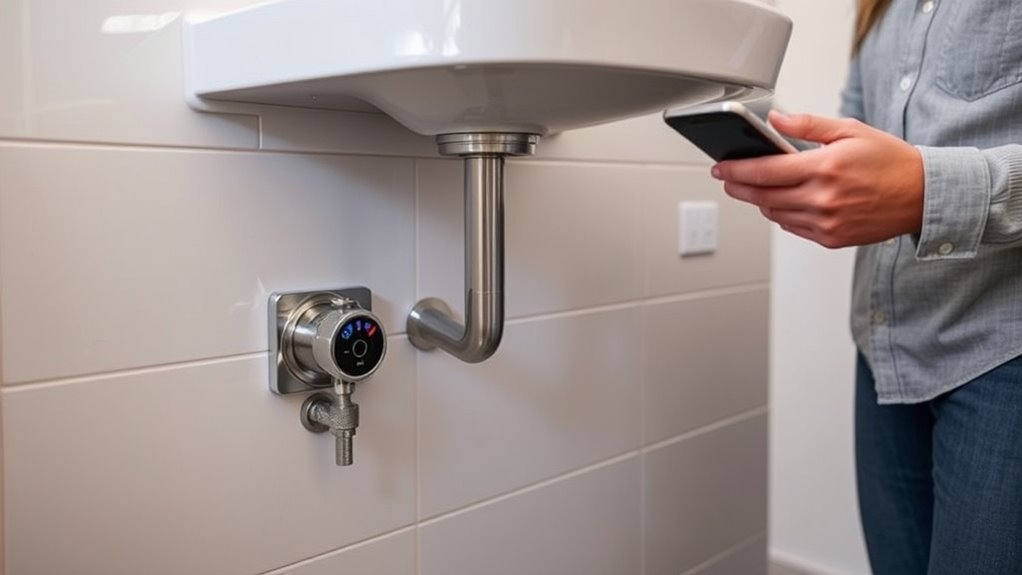
When choosing a Wi‑Fi water shutoff valve, you need to take into account safety certifications like NSF and Z-Wave Plus, which ensure the device meets strict safety and communication standards. Look for features like leak alerts, backup power, and temperature monitoring that protect your home from damage. Verifying compliance with local plumbing codes and safety standards helps ensure your installation is both safe and legal. Additionally, the device’s ability to connect up to 100 sensor cables and extend detection up to 500 feet enhances overall safety by providing comprehensive coverage of larger areas. Incorporating attention into the installation process can further improve the device’s effectiveness and reliability.
Certification Standards and Compliance
Certification standards and compliance play an essential role in ensuring your Wi-Fi water shutoff valve is safe, reliable, and ready for installation. These standards verify that the device meets safety, performance, and environmental requirements. Key certifications include:
- Third-party testing for safety and reliability, ensuring impartial validation.
- IAPMO IGC 349 and UL 1951 standards for smart valve functionality and electrical safety.
- Water quality certifications like NSF/ANSI 61 and 372, confirming materials are safe for drinking water and lead-free.
- Wireless device compliance, such as FCC Part 15, ensuring minimal interference and proper emissions.
Meeting these standards guarantees your device adheres to industry benchmarks, local codes, and regulatory requirements, providing peace of mind and long-term performance.
Safety Features and Protections
Safety features and protections are critical components of Wi-Fi water shutoff valves, ensuring they operate reliably even in emergencies or unexpected situations. These systems include fail-safe mechanisms that prevent accidental closure or failure during power or Wi-Fi outages, maintaining constant protection. These Fail-safe mechanisms are essential for continued operation when the system encounters disruptions, such as power failures or network issues. Integration with emergency protocols allows quick water isolation when anomalies are detected, reducing damage risks. Secure data encryption and privacy protections safeguard your personal information and system integrity. Many systems also include tamper detection and self-diagnostics, helping identify issues early. Additionally, regulatory standards guide the design and certification of these devices to ensure safety and reliability. Continuous firmware updates improve security and safety features over time. These protections ensure your system remains dependable, providing peace of mind by preventing leaks, minimizing water damage, and supporting safe operation during unforeseen events.
User Experience and App-Based Control Benefits

Using Wi-Fi water shutoff valves offers a seamless user experience, making water management straightforward and convenient. You can enjoy benefits like:
Wi-Fi water shutoff valves simplify water management with remote control and instant alerts.
- Easy installation, similar to other plumbing valves, with minimal setup time.
- A learning period to understand your water usage patterns, reducing false alerts.
- Alerts via text, email, or calls that notify you immediately of leaks.
- App-based control, allowing you to manage valves remotely for quick, flexible responses. Additionally, many systems incorporate remote monitoring features that enable constant oversight of your water system from anywhere.
These features provide peace of mind, enabling you to monitor water consumption in real time, shut off the water supply remotely when needed, customize notifications for your preferences, and integrate with other smart devices. This combination creates a user-friendly and efficient flood prevention system. User feedback and reviews can help you choose the best system for your needs.
Leading Devices and Market Trends
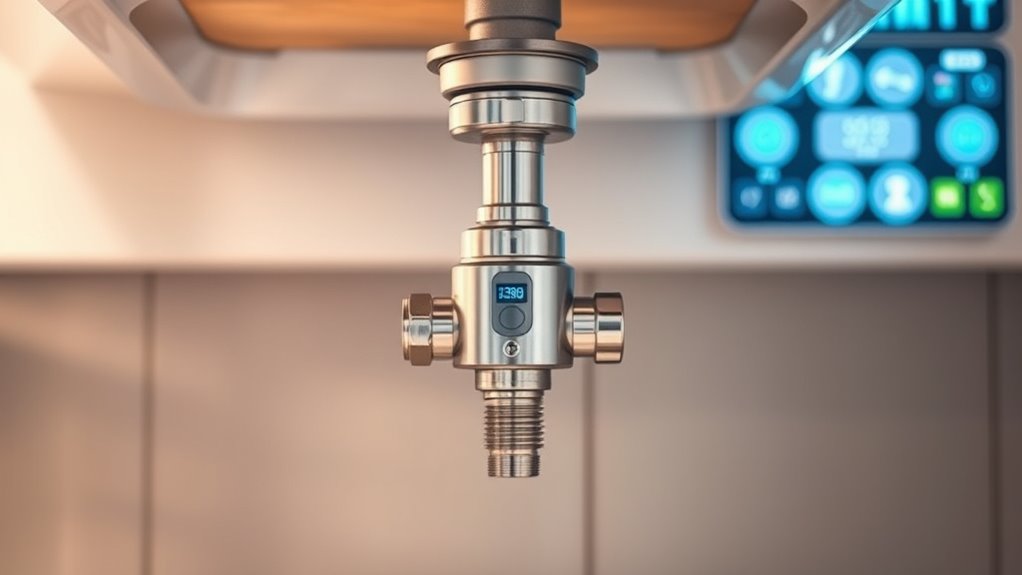
The market for Wi-Fi water shutoff valves is rapidly evolving, driven by advancements in device capabilities and shifting consumer preferences. Leading devices like Owfeel excel in quality, durability, and user popularity, while EcoNet offers reliable performance at a great price. Tokatuker stands out for easy installation and stable connectivity, and YoLink provides long-range LoRa communication ideal for large homes. UseeLink balances features with durability and responsiveness. Most top devices include automatic leak detection and shutoff, real-time flow monitoring, and integration with smart home apps. Consumers now prefer plug-and-play systems that work seamlessly with existing setups, supporting whole-home protection. Insurance discounts and improved leak detection algorithms also influence buying decisions, making these devices more appealing for a range of household sizes and needs. The demand for reliable, easy-to-install smart water management systems is increasing, as homeowners seek cost-effective solutions that enhance safety and convenience. Additionally, the integration of smart technology into these devices allows for more precise control and monitoring, further driving market growth.
Future Developments in Smart Water Control Technology
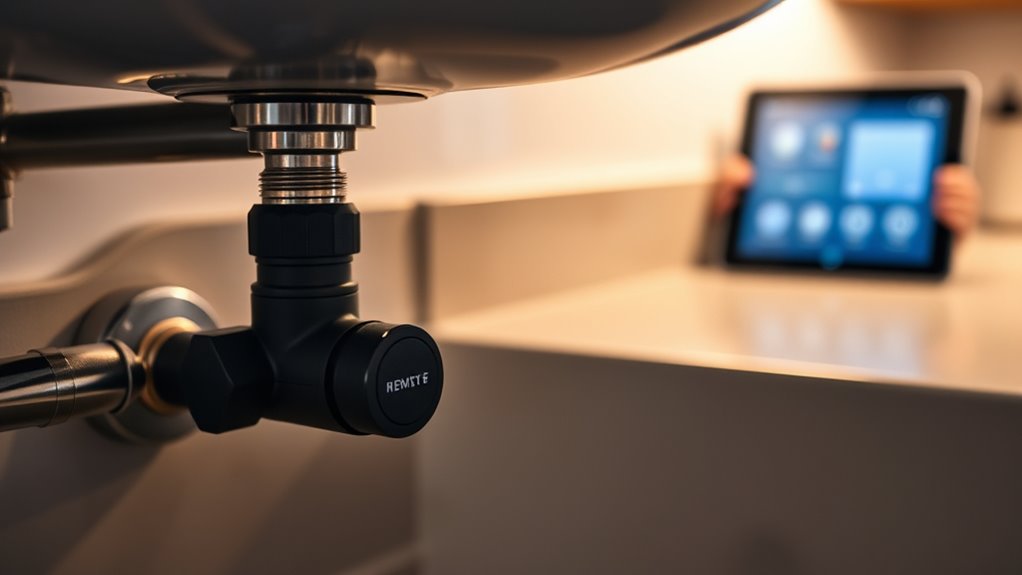
Advancements in smart water control technology are transforming how households and utilities manage water resources. You’ll see AI-driven predictive maintenance, which targets equipment failures before they happen, minimizing disruptions. Operational intelligence platforms centralize data, enabling faster incident responses. Algorithms now optimize water flows and detect anomalies in real time, reducing risks. Utilities increasingly leverage AI to automate chemical dosing and process adjustments, enhancing efficiency. Furthermore, cybersecurity measures will become even more critical as digital water systems become more interconnected, requiring robust protection against potential cyber attacks. Future developments include:
Smart water control integrates AI and IoT for efficient, predictive, and autonomous water management systems.
- Remote and autonomous water management systems that enable control from any location.
- Integrated platforms that unify water treatment and distribution for seamless operation.
- Enhanced cybersecurity measures to protect critical infrastructure from cyber threats.
- IoT and cloud-based platforms providing real-time data, leak detection, and analytics for smarter resource use.
Frequently Asked Questions
How Long Does the Battery Last in Wi-Fi Water Shutoff Valves?
You’re wondering how long the batteries last in Wi-Fi water shutoff valves. Battery life varies depending on usage and features, but generally, they last from one to two years with normal use. Frequent valve activations and sensor alerts drain power faster. Rechargeable backups like Water Hero can operate for up to three days during outages, ensuring continuous protection. Regular maintenance and monitoring help keep these systems reliable, preventing unexpected shutdowns.
Can These Valves Work During a Power Outage?
You wonder if these valves work during a power outage. Without a backup, they rely on household power and Wi-Fi, so they become unresponsive when power’s out. Some models include batteries or UPS systems that keep them functioning, allowing leak detection and automatic shutoff. It’s smart to choose a valve with built-in backup or manual override options, ensuring flood prevention even during outages. Regular maintenance helps keep these systems ready.
Are Wi-Fi Water Shutoff Valves Compatible With Smart Home Systems?
You’re wondering if Wi-Fi water shutoff valves work with smart home systems. They often do, supporting platforms like Google Home, Alexa, and SmartThings, helping you control water remotely. Compatibility varies by model, so check specific features. Many connect directly or through hubs, and some support protocols like Z-Wave or Matter. With these, you can automate, receive alerts, and control your water supply seamlessly within your existing smart home setup.
What Is the Typical Installation Time for These Devices?
The typical installation time for Wi-Fi water shutoff valves varies between 30 minutes and 2 hours, depending on the device model and your experience. If the pipe access is straightforward, it can take under an hour, especially with a licensed plumber. However, more complex setups, like retrofitting or working in hard-to-reach areas, may take longer. Preparing tools and shutting off water beforehand helps speed up the process.
How Do Leak Sensors Differentiate Between Real Leaks and False Alarms?
You wonder how leak sensors tell real leaks from false alarms. These sensors use advanced algorithms, combining data from multiple sensor types like resistive, capacitive, and infrared. They analyze real-time data, adjusting sensitivity based on humidity or environmental changes. When a leak is confirmed, you get smart notifications, and automatic shutoff valves can activate, stopping water flow. This smart detection minimizes false alarms and guarantees precise leak identification.
Conclusion
With Wi-Fi water shutoff valves, you can prevent floods and save thousands in damages. Did you know that smart water management reduces leak-related costs by up to 50%? By embracing these devices, you gain remote control, instant alerts, and peace of mind. As technology advances, expect even smarter, more reliable solutions—giving you full control over your home’s water system wherever you are. Stay ahead and protect your home effortlessly.
I’m Theodore, and I love tiny houses. In fact, I’m the author of Tiny House 43, a book about tiny houses that are also tree houses. I think they’re magical places where imaginations can run wild and adventures are just waiting to happen.
While tree houses are often associated with childhood, they can be the perfect adult retreat. They offer a cozy space to relax and unwind, surrounded by nature. And since they’re typically built on stilts or raised platforms, they offer stunning views that traditional homes simply can’t match.
If you’re looking for a unique and romantic getaway, a tree house tiny house might just be the perfect option.
